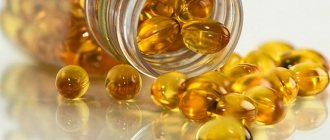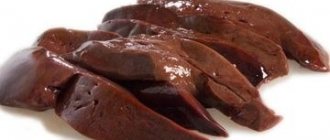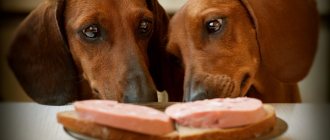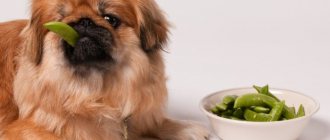When caring for your pet, you want to not only surround it with care and attention, but also provide the most varied diet possible. Therefore, sometimes owners deviate from the usual advice of dog handlers and pamper their dogs with prohibited foods.
Mushrooms are also on the list of not recommended delicacies. Is it worth giving your dog such an exotic addition to his food and how often is this allowed? Every owner of a four-legged friend should take note of the rules for combining mushrooms with standard pet food.
Why can't you give?
Acute or unexpected poisoning of pets is one of the most pressing problems, although in veterinary practice these cases occur in only 1–2% of diseases.
Often the cause of such sad incidents is the inattentive attitude of the owners. And the situation when, during a walk, a dog ate some kind of mushroom without permission is a fairly common occurrence.
Harm
An absolute threat to dogs is the ripe fruiting bodies of large puffballs in the spore dissemination stage. Active animals often become victims of lycoperdonosis by inhaling allergenic spores while playing or exploring the territory.
Many dogs die every year from fungi containing amatoxins (capillary toadstool). But the first manifestations of allergies can be stopped in a timely manner and your pet can be quickly treated.
With poisoning, things are much more complicated: toxic substances have already begun to interact with the body, and at least 1-2 hours have passed from the moment of taking mushrooms to the detection of poor health, if not more. Here you need to act quickly and definitely contact a veterinarian for help.
Not only poisonous mushrooms, but also edible ones can cause harm. They can also pose a threat to the pet’s health if they were found near sources of anthropogenic pollution (intensively exploited agricultural landscapes, industrial enterprises, highway sides).
It is precisely because of the contradictory reaction of the dog’s body to mushrooms that such food should be avoided if you value the well-being of your four-legged friend.
Is there any benefit?
Mushrooms are known to contain niacin, riboflavin, vitamin D and an antioxidant. At first glance, the composition includes useful elements that are often found in dry dog food.
But, despite this coincidence, it is not worth including them in the animal’s diet. Mushrooms themselves do not provide any benefit to dogs, so their absence from the diet can be considered a more reasonable solution than trying to feed your pet an unusual additive.
Portability
It is impossible to predict what reaction each type of mushroom will give in the case of a specific breed: even with edible variations you should be careful. Many dog handlers are guided by the opposite principle: the absence of mushrooms will not negatively affect the health of the pet, so there is no need to give the dog such a product “just like that.”
General information about mushrooms
The gifts of the forest not only have gastronomic value, which dogs are unlikely to appreciate, but they are rich in nutrients and vitamins.
It’s not for nothing that their second name is “forest meat.” They contain a large amount of protein and at the same time a minimum of fat.
Compound
The chemical composition of the product is unique: 90-95% is water, the rest is dry substances (lipase, proteinase, etc.).
Mushrooms also contain:
- vitamins of group B, PP, C;
- healthy fatty acids (palmitic, butyric, etc.);
- about 20 amino acids;
- zinc;
- riboflavin;
- copper and manganese;
- iron and potassium;
- thiamine
Mushrooms contain healthy fatty acids, iron and potassium.
Some varieties are rich in fiber, others are high in protein. The product contains many antioxidants, but when cooked, most of them are destroyed.
Calories and nutritional value
The calorie content of mushrooms is low - within 10-34 kcal per 100 g.
The nutritional value of the product is as follows:
- in terms of composition and amount of carbohydrates, forest products are close to plants, but they still contain insulin and glycogen;
- Mushrooms contain the same amount of vitamins as liver and yeast, but many of them are destroyed during cooking (for example, carotene);
- 70% of the dry substances in the product are proteins, so it has high nutritional value and gives a feeling of satiety;
- The content of minerals (potassium, copper iodine, etc.) in mushrooms is small, but this is enough to saturate the body.
Boiled or raw?
The safest mushrooms for your pet are those that have undergone minimal heat treatment. Oddly enough, it is better to buy them in a supermarket than to personally collect them in the forest, especially if you have doubts about the subspecies you found.
It is strictly forbidden to give your dog raw mushrooms. Both the cap and the stem may collect additional allergens, and simply washing them in water will not eliminate them. At a minimum, you need to lightly boil the pulp. In this case, it is better to pour out the broth water in which the mushrooms have reached readiness and exclude any seasonings.
Salted and fried
In addition to the harm of mushrooms as such, do not forget that pets cannot eat the same food that people are used to eating.
Dishes that require long-term frying and a lot of spices (even salt and pepper) can cause serious complications in the animal’s digestive system. Such a diet cannot be given even without mushrooms, and together with a dubious ingredient, their danger doubles.
Soup
The safest of similar recipes is mushroom soup. Due to pasta and potatoes, the concentration of taste becomes slightly diluted and it is extremely rare to pamper your pet with a plate of such a mixture, but not more often.
Other versions of the menu, which feature mushrooms along with a generous addition of butter, seasonings and dough, pickling and canning, should be excluded and not share your culinary achievements with your pet.
Foods to eat in moderation
What can you feed your Sphynx?
Milk
Over time, the body of many adult animals loses the ability to break down the lactose contained in milk. Drinking milk threatens them with stomach upsets and diarrhea.
But completely eliminating dairy products from your diet is wrong. You just need to replace them with fermented milk products with low lactose content. These can be yoghurts, low-fat cottage cheese and kefir.
Cheese
Many dogs love cheese. As with milk, many dogs are intolerant to lactose, which is found in cheese. Therefore, if you want to treat your pet to cheese, then opt for a product with a low fat content.
Strawberries, blueberries, apples and other fruits
Fruits and berries are very healthy for dogs. But they should be given in moderation. Fruits and berries contain a lot of fiber, which promotes proper digestion. But we must not forget that the main part of a four-legged diet should be meat.
For more information about which fruits can be safely included in the diet, and which should be given in limited quantities, read the article: Which fruits can be given to a dog and which cannot.
Cabbage
Cabbage itself is not harmful to dogs. But consuming this product in large quantities can cause flatulence.
In conclusion, I want to add just one thing.
Never feed your pet foods you are not sure about. If you have problems with your dog's health, immediately seek help from a veterinary clinic.
Good luck and take care of your pets!
What to do if things get bad?
The most poisonous mushrooms for dogs are considered to be pale toadstool, spring and stinking fly agarics, talkers, sulfur-yellow false honey fungus, false puffballs and poisonous southern boletus mushrooms.
While other mushrooms risk causing mild poisoning, the listed species have a strong toxic effect on the cardiovascular system, central nervous system, gastrointestinal tract, liver, kidneys - almost all vital organs. Poisoning usually has symptoms similar to those in humans:
- constant nausea, vomiting;
- moaning due to abdominal pain;
- diarrhea (usually bloody);
- increased thirst;
- body temperature drops to 35-36°C;
- the pulse is slow and barely detectable;
- inhibited reaction;
- lying down;
- excessive salivation;
- convulsions.
It is necessary to urgently call a veterinarian and be prepared to name the mushrooms that you gave the dog - this will greatly facilitate the treatment process. You should also perform one of the suggested activities yourself:
- rinse your pet’s stomach with water or a pale pink solution of potassium permanganate;
- introduce activated charcoal into the stomach;
- give strong sweet tea, coffee with milk, then give castor oil (from 1 tsp to 100 g, depending on the weight);
- briefly apply a cold compress or a heating pad with cold water to your head.
It is important not to waste time and immediately identify the first manifestations of the problem. Mushrooms have a habit of accumulating in the body, so if you periodically spoil your pet with such food, the consequences may occur even years later. If the owner does not take retaliatory measures, then if poisoned, the dog may fall into a coma or even die.
How to provide emergency assistance
In case of severe poisoning, emergency assistance can save the animal from death. In any case, you need to call a veterinarian, but you will have to take certain measures yourself. First aid includes the following measures:
- Eliminate contact with a poisonous product.
- Provoking artificial vomiting in an animal. It is necessary to pour one of these compositions inside: a saline or soda water solution at the rate of 1 tbsp. l. for 200 ml of water; an aqueous solution of hydrogen peroxide (3%) in equal proportions. Liquids are given warm. The dose is calculated as follows: 1 tbsp. l. for every 3 kg of weight.
- If there is a toxic composition on the fur or skin, wash the area thoroughly with warm water and baby soap.
- In case of carbon monoxide poisoning, you need to wash your eyes and mouth with a soda solution (3%).
- Introduction of adsorbent: activated carbon (2 g per kilogram of body weight), Enterosorb, Enterosgel.
- The use of laxatives and enveloping drugs after using adsorbents (after 30-40 minutes).
- Introducing the following folk remedies to the animal through the mouth: decoction of flax seeds; highly diluted starch paste; a mixture of egg white and water in equal proportions; a solution of Glauber's or Carlsbad salt as a laxative; oil-type laxative composition.
- You should not try to give your dog milk, it will only speed up the absorption of toxins by the body.
Why does he want to eat?
Dogs, especially young and active ones, are very curious and try to taste everything new when walking. It has been repeatedly noted that pets have a special interest in the pale grebe, the stinking fly agaric and toxic fibers. This may be due to their fishy smell.
However, talkers also pose a serious threat, because four-legged animals are very sensitive to muscarine: a dose that does not pose a threat to human life will be lethal for a dog. A common cause of intoxication in dogs are fly agarics, which also have an attractive smell.
How to wean it off?
To avoid unwanted tasting, you should train your dog not to pick up anything from the ground without a command. But if the pet is already an adult, it will be difficult for him to learn this command, so the owner himself will have to demonstrate attentiveness.
The owner must monitor the pet, keep it on a leash in the forest or park, and keep it away from trunks and stumps where mushrooms can grow.
If you live in a private sector, then you need to periodically inspect the area for the appearance of toadstools (especially after rain in the spring-autumn period) and remove them before the dog notices.
Getting to know the smell
The dog will search for mushrooms by smell. To do this, she needs to get used to it; the easiest way to do this is by adding a small amount of mushroom broth to her food for several days at one feeding. Moreover, the decoction must be made from those mushrooms for which the “hunt” is planned.
At the same time, you can let your pet sniff a fresh mushroom. It is better to use gloves so that the pet does not get confused by odors and is not guided by the smell of the owner.
By the way, some pets look for mushrooms without training. It's all about the animal's interest. Some pets like to sit next to their owner while they are cleaning mushrooms. This should be used by strengthening the connection between the smell that the dog smells and the positive sensations that the animal experiences while in the epicenter of the smell.
The next stage of training is to apply a few drops of mushroom broth to your pet’s favorite toy, then hide it and give the dog the command to find the toy. If the animal finds a toy, you should definitely reward it with a treat.
The practical stage of training consists of searching for real mushrooms hidden in an area familiar to the animal, for example in a garden. On command, the pet must find the specimens. After several days of successful practice, you can go into the forest.
For puppies
Small pets have a habit of trying everything that catches their eye. Moreover, it is not necessary that this item be edible. Therefore, soft and attractive-smelling mushrooms are a desirable prey for young researchers.
But this product is even more dangerous for puppies than for an adult dog. Due to the completely unformed organism and small mass, even a minimal portion of mushrooms can be very dangerous for them. Dog handlers prohibit giving children mushrooms in general, regardless of the type and method of preparation.
Content
1. What are the benefits of mushrooms 2. Should you give them to your dog 3. In what form and how much can you use 4. How to wean them off
Some pets beg their owners for food that seems completely inedible for them. And then the owners have a question: is it possible to give the dog mushrooms, berries and similar foods? On the one hand, the gifts of the forest contain many nutrients beneficial to the body, on the other hand, there is a high risk of digestive dysfunction and the possibility of poisoning. So is it worth indulging your pet’s whims?
Pregnant and lactating
Even if mushrooms in large quantities are contraindicated for a healthy dog, then this product should not be given to females who are bearing offspring in principle.
Previously, there was an opinion that bitches could and even should be given champignons, honey mushrooms, boletuses, chanterelles and saffron milk caps, but now this statement has been refuted.
In case of poisoning, the dog and its offspring are more difficult to tolerate the symptoms, but the risk that the puppies will then be born dead is very high. Therefore, breeders exclude any mushroom supplements from the diet of both pregnant and lactating animals.
What types of mushrooms can you give?
Each type of mushroom is useful in its own way.
For example, boletus mushrooms contain a lot of protein, chanterelles have antibacterial properties, and the skin of the boletus is a natural antibiotic. Boletus is a good antioxidant that helps speed up the process of removing toxins from the body. Artificially grown varieties such as champignons and oyster mushrooms are also useful. The latter are a source of a substance called lovastatin, which reduces the level of bad cholesterol in the blood. Oyster mushrooms also remove toxins from the body. Champignons contain a high concentration of vital amino acids - arginine and lysine. Each owner decides for himself which mushroom to give to his pet.
But it is better to offer the product that is sold in the supermarket, and not picked in the forest. In this case, the risk of the dog getting poisoned is lower.
Breed exceptions
There are no comments about individual breeds. But it is worth considering the different parameters of pets.
Large breeds that have an impressive body weight can normally tolerate an inappropriate portion of mushrooms and have at most problems with bowel movements.
But for smaller representatives, especially exotics (Spitz, pug, Yorkshire terrier), eating mushrooms is fraught with the most serious symptoms.
If you notice unusual behavior in an animal, then in the case of tiny four-legged friends you should act especially quickly: breeds weighing up to 3 kg are at risk and require special attention from their owners.
Nuances of use
As nutritionists advise, mushrooms should not be consumed more than 2-3 times a week, so as not to overload the gastrointestinal tract.
Can it be eaten raw?
Chefs on TV insistently offer dishes prepared with raw champignons, since they retain all the vitamins. Of course, they must be freshly cut.
But no one explains what to do with hydrazines. This group of chemical compounds is classified as carcinogens and is easily removed by heating. Therefore, decide for yourself whether you want to eat mushrooms without heat treatment or not.
During pregnancy
If a pregnant woman consumes foods that cause allergic reactions, this can affect the baby. After birth, he may develop diathesis, then food allergies and, as a result, bronchial asthma. If you have an individual intolerance to champignons, you need to find out before pregnancy.
In addition, mushrooms are difficult to digest food, and a woman who is carrying a child is contraindicated in foods that cause fermentation and gas production. They put pressure on the diaphragm, as a result of which the pregnant woman’s breathing becomes difficult, which leads to oxygen deficiency in the fetus.
The hormonal background changes during this period, the body is rebuilt, so additional stress on it is undesirable. If you have eaten champignons before, and there were no consequences, then you can afford them no more than 150 g per day and no more than three times a week.
Is it possible for children
Feeding champignons in any form to infants is prohibited. Mushrooms contain chitinous fibers, which are not digested in the child’s stomach.
It is forbidden to feed mushrooms to children under 8 years of age due to the imperfection of the digestive system. Their gastrointestinal tract does not yet have the full composition of enzymes for the absorption of this product.
For various diseases (pancreatitis, diabetes, gastritis, etc.)
The absence of sugar in champignons allows people diagnosed with diabetes to include them in the diet.
If you have diseases of the gastrointestinal tract, you should avoid eating mushrooms, as this causes inflammation of the pancreas (pancreatitis), gastritis and gastroduodenitis.
Don’t trust mushrooms collected in the forest - they absorb all the negativity of roads and exhaust like sponges.
You should not eat champignons if you have gout, as they contain purine bases (25 mg), which is the cause of this disease. An increase in uric acid will also worsen gout.
If hepatitis is mild, you can eat mushroom soups, but during an exacerbation it will only cause harm.
Endometriosis requires a specific diet that limits fat intake. For this reason, doctors recommend reducing meat intake, as it contains fats. To compensate for the decrease in protein intake, mushrooms are introduced into the diet. They help regulate hormonal imbalances in the female body.
Chocolate
We all probably give our dogs a little chocolate. It tastes good and they love it, there is even a special chocolate for dogs, strange, but still chocolate. However, our regular chocolate is one of the worst foods you can give your dog. Theobromine in chocolate is the culprit, an ingredient that is toxic to dogs and causes them to vomit and have diarrhea. The dog will become thirsty and may develop arrhythmia, which can eventually lead to seizures and even death. The worst chocolate for dogs is dark chocolate, which contains even more theobromine than, for example, milk chocolate. Therefore, if you come to share chocolate with your dog, it is better to buy special chocolate designed specifically for dogs.
Should I give it to my dog?
If mushrooms are so healthy, then you can give them to your pets without fear? There's no need to rush. One mushroom may not cause any harm, although it is a heavy food that cannot be digested by the body of any mammal. The reason for this is the protein chitin, an excess of which can lead to gastritis and more serious diseases of the gastrointestinal tract.
If the dog likes the taste, during a walk in the forest he may smell a familiar smell and accidentally eat a poisonous mushroom. And this is the biggest danger of eating mushrooms for pets - the risk of serious food poisoning. Even if you are well versed in mushrooms, an accidental wormy or poisonous one can ruin the entire “harvest.”
Diet rules during the recovery period
The next day after symptoms have eased, you need to evaluate your overall health. If there is no appetite, then you should not eat forcibly. It is enough to drink water, compote, fruit juice or herbal tea. There is no need to be afraid of a lack of appetite; this is a normal reaction of the body to dyspeptic disorders during poisoning. Overeating and eating without appetite will not bring health improvement and, on the contrary, will provoke complications.
It is important to avoid foods that irritate the mucous membranes and cause heartburn. The presence of an inflammatory process and aggressive foods can contribute to the development of erosive lesions of the stomach walls
When you have an appetite, you need to take it in moderation. The stomach has not yet recovered enough to process the usual food. Haste can harm the recovery process and provoke serious disturbances in the microflora of the intestines and stomach.
Important! All dishes in dietary and therapeutic nutrition are steamed and served boiled. Main courses are usually ground in advance through a sieve or blender
Such a supply is mandatory when recovering from poisoning of a child’s body.
Helpful: Signs of a broken finger
How to treat fungal dermatitis?
Treatment of fungus in dogs at the initial stage of the disease is carried out using a local method using shampoos or ointments. In advanced stages, drug treatment is carried out, which uses antifungal drugs.
Treatment of fungal dermatitis consists of the following series of measures:
- relief of itching and local anesthesia;
- treatment of affected skin areas with special ointments;
- systemic antibiotic therapy;
- detoxification and strengthening therapy.
A specific course is prescribed taking into account the general condition of the pet. To improve the clinical picture, the veterinarian may use the following treatments and medications for dogs.
- Local treatment according to the following scheme: ointment or cream (synthomycin ointment, Levomekol or Vishnevsky ointment) is applied to dry affected areas of the skin. The dressings are changed 1-2 times a day. Drying antimicrobial agents in the form of powders or solutions (streptocide or a solution of iodoform with boric acid) are applied to open wounds, weeping ulcers and pustules.
- Treatment with the antifungal agent fluconazole is effective. Pain syndrome is relieved by intravenous administration of 0.25% novocaine (dosage 5-20 ml, taking into account the weight and characteristics of the animal). The dog's condition is closely monitored by a veterinarian for several hours after the injection. Itching can be relieved with suprastin, tavegil or other antihistamines.
- Antibiotic therapy is actively used in cases of prolonged purulent disease. The course of treatment may be as follows: 15-30 mg/kg cephalexin 2 times a day for 1 week, 5-10 mg/kg enrofloxacin 1 time a day for 5 days and 0.2 ml/kg baytril 1 time a day for within 5-10 days depending on the condition of the infected animal.
- Autohemotherapy is necessary to improve the animal's condition. A modern method of skin treatment involves subcutaneous or intramuscular injection into the affected area of 5 ml of blood taken from the antebrachial saphenous vein. A total of 4 injections are given every 2, 3 or 4 days, depending on the course of the dog’s illness.
- Vitamin therapy is essential to improve immunity. In addition to the main treatment, the veterinarian additionally prescribes vitamins A, PP, B and E, immunofan, cycloveron and gamavit.
Therefore, in order to cure dermatitis, you should immediately contact a veterinary clinic, where the doctor will conduct all the necessary studies, examinations and prescribe effective treatment. To avoid the formation and infection of a fungal infection, a number of preventive measures must be followed.
Macadamia nuts
The situation with macadamia nuts is a little strange. According to the Merck Veterinary Manual, dogs are the only creatures to whom macadamia nuts are poisonous. Usually, these nuts simply make the dog weak and remain ill for quite a short time, however, if the dog eats nuts in combination with chocolate, this often leads to the death of the animal.
Additional recommendations
The ideal drink for a pet is fresh and clean water. He should always have access to it. With its help, the animal not only quenches thirst, but also regulates body temperature. If there is no water, it is better not to give anything, because... other liquids acceptable to humans will only cause harm to the pet.
Dogs actively explore the world around them and taste almost everything. They can eat a newspaper, shoes, drink coffee, etc. A person’s task is to monitor and care for a pet, especially carefully when looking after puppies.
Even if you can't help yourself and want to share the food you eat yourself with your dog or cat, do it wisely. There is nothing wrong if you give your pet a piece of boiled meat or carrots. You can cheat and instead of food from the table, offer a treat from a pet store. This way you will please your pet and not harm his health.











